Affiliate links on Android Authority may earn us a commission. Learn more.
How It Works: AMOLED Displays

You’ve heard the AMOLED term a bunch of times when looking for more information about a certain smartphone (especially an Android-powered one) or when actually talking with the in-store carrier representatives about the characteristics that differentiate various mobile devices between them. Whether you already know what AMOLED is or not, we’re going to thoroughly explain it for you, so next time you buy a mobile device and somebody tells you it’s got an AMOLED screen of some sort, you know exactly what they’re talking about.
You might like: AMOLED vs LCD – What is the difference?
What is AMOLED?
AMOLED is a display technology used in some of the most popular mobile devices available today, including various Android handsets and tablets that you see featured on Android Authority on a regular basis. AMOLED stands for “active-matrix organic light-emitting diode” – a rather complex term that you don’t have to remember as long as you know how it works.
The technology, especially used in Samsung-made Android devices, is very popular among Android device makers, although not everyone in the mobile game can use it as they please. Because Samsung is one of the main AMOLED panel makers, we’re not surprised to see the displays used especially in Samsung devices, with its direct competition (HTC, Motorola and others) having to sometimes wait for longer periods of time to get their AMOLED supplies, and even to replace AMOLED panels with different screen technology altogether.
How do AMOLED displays work?
OLED-Displays bests describes how AMOLED displays work:
Active matrix (AM) OLED displays stack cathode, organic, and anode layers on top of another layer – or substrate – that contains circuitry. The pixels are defined by the deposition of the organic material in a continuous, discrete “dot” pattern. Each pixel is activated directly: A corresponding circuit delivers voltage to the cathode and anode materials, stimulating the middle organic layer. AMOLED pixels turn on and off more than three times faster than the speed of conventional motion picture film – making these displays ideal for fluid, full-motion video.
What you should remember is that AMOLED displays will offer a great viewing experience, whether we’re talking about videos, games or pictures. The image is superior, in some cases, than the one experienced on devices using different screen technology, and it offers a better performance in direct sunlight (again, in some cases.)
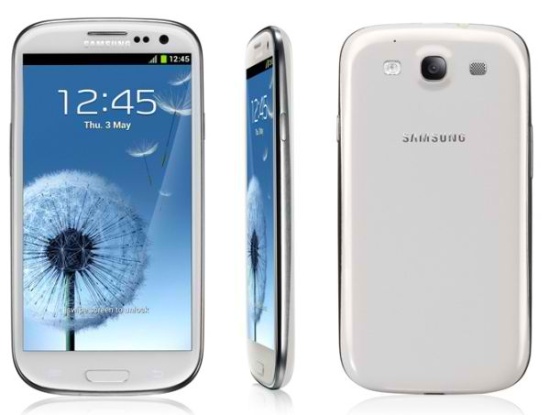
Samsung Galaxy S III with HD Super AMOLED Display
Also worth mentioning is that AMOLED display offer faster response time, higher refresh rates, are more and more power-efficient (especially more advanced variants,) a major feature when it comes to mobile device use. Less power consumption means that smartphone and tablet makers can offer a better image without affecting battery life, especially in a mobile environment that’s getting ready for 4G LTE technology, another power devourer for mobile devices.
AMOLED: Super, HD, Plus & others
Naturally, the AMOLED development is going forward, with various companies further experimenting ways of taking advantage of the technology in future devices. Therefore, you shouldn’t be surprised to hear various other terms used in conjunction with AMOLED. These include: Super AMOLED, Super AMOLED Plus, Super AMOLED Advanced and HD AMOLED Plus. Such displays are found in various Android handsets and tablets available in stores right now. Here’s what it all means:
Super AMOLED is what Samsung calls its own AMOLED display technology because the display actually includes a digitizer (the component of the screen that detects touch). Super AMOLED screens offer a much better viewing experience in sunlight conditions and it is found in some popular devices including: Samsung Galaxy S, Google Nexus S, Samsung Focus and Samsung Omnia W.
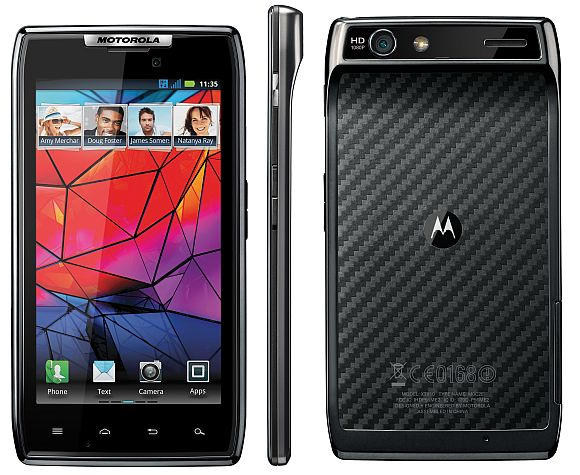
Motorola Droid RAZR with Super AMOLED Advanced Display
Super AMOLED Plus is another display-related term marketed by Samsung. In comparison to AMOLED and Super AMOLED displays, the Super AMOLED Plus displays are even more energy efficient and brighter. You’ll certainly recognize some of the Android devices that employ such panels: Samsung Galaxy S II, Samsung Droid Charge and Samsung Infuse 4G.
Super AMOLED Advanced is a term marketed by Motorola that’s supposed to described a brighter display than Super AMOLED screens, but also a higher resolution – qHD or 960 x 540 for Super AMOLED Advanced compared to WVGA or 800 x 480 for Super AMOLED. This display equips the Motorola Droid RAZR.

Samsung Galaxy Note with HD Super AMOLED Display
Finally, HD Super AMOLED describes those mobile panels that offer a higher (HD) resolution, typically 1280 x 720 pixels or even higher. The following devices have such panels on board: Samsung Galaxy Note, Samsung Galaxy Note, Samsung Galaxy S III and Samsung Galaxy Tab 7.7 (technically, the tablet comes with a superior HD Super AMOLED Plus display).
Which AMOLED display type is best for me?
When it comes to choosing your next smartphone, the size of the display and the technology behind it can be pretty important, although these are not the only factors you should be interested in when purchasing the device – other things to consider include processor speed, 3G/4G support, OS version and upgradeability, battery life, compatibility with worldwide carriers and even camera(s) performance.
But when it comes to choosing between the different AMOLED displays mentioned above, you’ll need a deeper understanding of how these display work and how they could better suit your needs.
- Are you looking for finer images?
- Do you plan to use the device out in the open a lot?
- Are you constantly streaming videos and using graphics-rich apps and games?
These are things you should think about when choosing an AMOLED display type.
In other words, there isn’t necessarily a best one, but if you were to choose a device by the kind of AMOLED display it comes with, then you’d better get a Super AMOLED Plus or HD Super AMOLED screen. These are the kind of panels that you’ll find in the latest Android handsets from Samsung, therefore the devices that equip such panels will certainly meet your needs when it comes to CPU performance, connectivity choices or OS version.
The Super AMOLED Plus panel has an increased number of subpixels, which means the image is crispier, close to Retina Display – but not necessarily, as a higher resolution is also needed to achieve such performance. The HD Super AMOLED display sacrifices sharpness in favor of a HD resolution. This is achieved by using the PenTile technology that’s also found in regular Super AMOLED screens, which uses fewer subpixels to achieve larger resolutions.
PenTile explained
PenTile or PenTile Matrix is a technology that refers to subpixel arrangement in AMOLED displays. PenTile screens have a RGBG (Red-Green-Blue-Green) pixel layout – see image below – compared to regular displays that rely on an RGB-RGB pattern. The advantage is that PenTile displays can offer a higher resolution utilizing less pixels, but the disadvantage is that image is not as sharp as you’d expect it to be exactly because less pixels are involved.
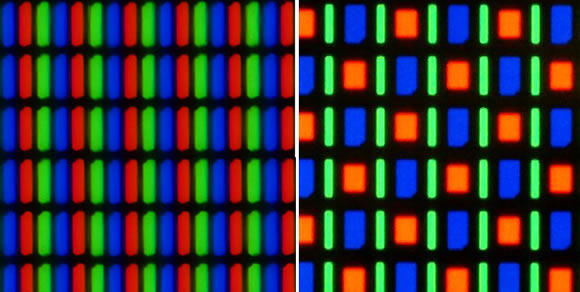
RGB-RGB Display (left) vs RGBG PenTile Display (right)
Of the AMOLED variants mentioned above, only the Super AMOLED Plus displays offer an RGB-RGB arrangement, and therefore are capable of offering a crisper image.
Other mobile display kinds
While AMOLED displays are mostly used by Samsung in their Android and Windows Phone devices, you are going to find various AMOLED panels in various mobile gadgets, from smartphones and tablets to PMPs, gaming consoles and digital cameras.
But since we’re focusing on Android devices over here, we’ll note that the competition can use other display technologies marketed under different monikers such as Retina Display (Apple) or SLCD (Sony, Samsung, HTC, others).
Other uses
AMOLED displays are currently used in mobile devices although we’re expecting the companies involved to continuously develop the technology to include it in bigger devices (namely HDTVs) once larger AMOLED panels become more budget-friendly. Samsung also happens to have a 40-inch AMOLED TV prototype seen in the following image:
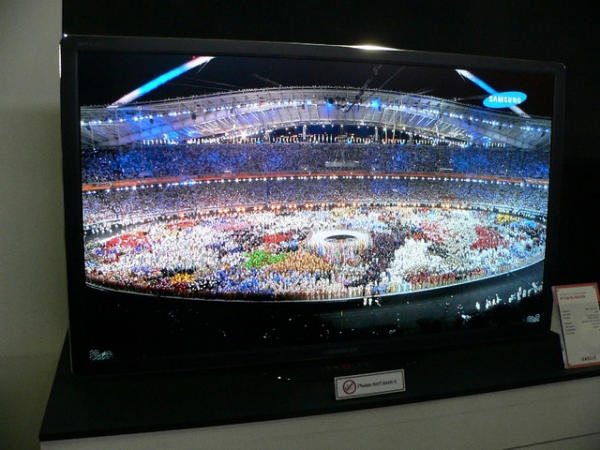
Samsung 40-inch AMOLED TV protoype
A recent iSuppli study revealed the challenges encountered by companies interested in mass-producing AMOLED TVs and suggested that only a few thousand such television sets will be sold this year, with production expected to increase gradually over the next couple of years. The following comparison chart shows the differences between AMOLED TVs and TV sets using other technologies, both when it comes to certain specs and features but also when it comes to prices:
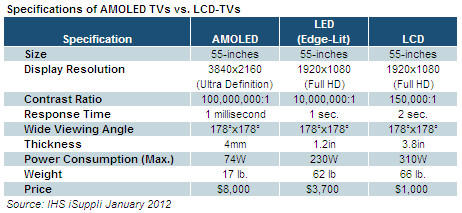
AMOLED TVs vs LCD TVs – via iSuppli
While we wait for AMOLED TVs to be mass produced, we’ll certainly see more and more smartphones and tablets ship with AMOLED displays on board, which we’ll certainly cover thoroughly for you here on Android Authority.